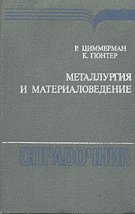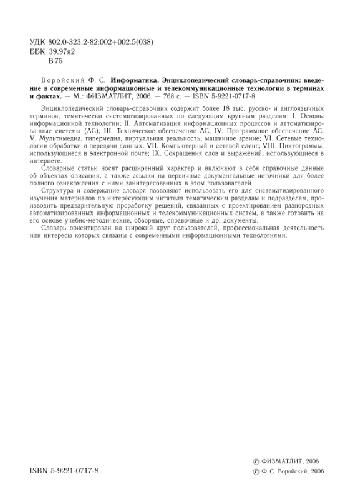J. Dakin, R. G. W. Brown9780750306461, 0750306467
Beginning with an introduction to the relevant principles of physics, materials science, engineering, and optics, the book explores the details of optoelectronic devices and techniques including semiconductor lasers, optical detectors and receivers, optical fiber devices, modulators, amplifiers, integrated optics, LEDs, and engineered optical materials. Applications and systems then become the focus, with sections devoted to industrial, medical, and commercial applications, communications, imaging and displays, sensing and data processing, spectroscopic analysis, the art of practical optoelectronics, and future prospects. This extensive resource comprises the efforts of more than 70 world-renowned experts from leading industrial and academic institutions around the world and includes many references to contemporary works.
Whether used as a field reference, as a research tool, or as a broad and self-contained introduction to the field, the Handbook of Optoelectronics places everything you need in a unified, conveniently organized format.
Table of contents :
Handbook of Optoelectronics……Page 1
Volume I……Page 3
Editorial Board……Page 5
List of contributors……Page 6
Acknowledgments……Page 9
Introduction……Page 10
Vol I. Contents……Page 13
Volume II……Page 15
Editorial Board……Page 17
List of contributors……Page 18
Acknowledgments……Page 21
Introduction……Page 22
Vol II. Contents……Page 25
A1.1.2 Historical sketch……Page 26
A1.1.3 The wave nature of light……Page 27
A1.1.4 Polarization……Page 31
A1.1.5 The electromagnetic spectrum……Page 33
A1.1.6 Emission and absorption processes……Page 34
A1.1.7 Photon statistics……Page 35
A1.1.8 The behaviour of electrons……Page 37
A1.1.10 Summary……Page 44
Further reading……Page 45
A1.2.2 Optical properties of some common materials……Page 46
A1.2.3 Crystalline and amorphous materials……Page 48
A1.2.4.3 Metallic bonds……Page 49
A1.2.5 The free electron model for metals……Page 50
A1.2.6 Electrons in a periodic lattice……Page 52
A1.2.7 Metals, insulators and semiconductors……Page 54
A1.2.8 Carriers, conduction and doping in semiconductors……Page 56
A1.2.9.1 Refraction……Page 57
A1.2.9.2 Absorption and emission……Page 60
A1.2.9.4 Scattering……Page 61
A1.2.10.1 Absorption and photo-conductivity……Page 63
A1.2.11 Polycrystalline and amorphous semiconductors……Page 65
A1.2.12 Glasses……Page 66
A1.2.13.1 Anisotropy……Page 67
A1.2.13.2 Electro-optic and nonlinear processes……Page 68
References……Page 69
A1.3.2 Light production……Page 70
A1.3.3.1 Full radiator radiation and limits on emission……Page 71
A1.3.3.3 Etendue……Page 72
A1.3.3.4 Use of light in systems……Page 73
A1.3.3.5 Colour properties and colour temperature of sources……Page 75
A1.3.4.1 Emission……Page 76
A1.3.4.2 Tungsten – halogen lamps……Page 77
A1.3.4.4 Lamps with integral reflectors……Page 78
A1.3.5 Discharge lamps with electrodes……Page 79
A1.3.5.1 Stable discharge operation of discharges with electrodes……Page 80
A1.3.5.2 Electrode regions……Page 81
A1.3.6.1 Low-pressure mercury rare-gas discharges……Page 82
A1.3.7 HP discharges……Page 83
A1.3.7.1 General features of HP discharge lamps……Page 84
A1.3.7.3 Operating principles of metal halide lamps……Page 86
A1.3.7.4 Applications of HP discharge lamps……Page 87
A1.3.8.1 Breakdown and starting in discharge lamps……Page 89
A1.3.8.2 Steady state electrical characteristics……Page 91
A1.3.8.3 AC operation……Page 92
A1.3.9.2 Dielectric barrier discharges……Page 93
A1.3.9.3 Excitation by induction and by microwaves……Page 94
A1.3.10 LEDs from the perspective of conventional lighting……Page 95
References……Page 96
Appendix. Selected manufacturers and suppliers of lamps……Page 97
A1.4.1 Detection regimes and figures of merit……Page 98
A1.4.2.1 Introduction……Page 103
A1.4.2.2 Selection of active amplifying elements……Page 104
A1.4.2.3 First stages of photoreceivers……Page 105
A1.4.2.4 Photon-counting techniques……Page 110
A1.4.2.5 High-speed photoreceivers……Page 112
A1.4.2.6 Noise models of first stages of photoreceivers……Page 114
A1.4.3.1 Signal averaging……Page 119
A1.4.3.2 Lock-in amplifier……Page 120
A1.4.3.3 Boxcar detection systems……Page 122
A1.4.3.4 Coherent detection……Page 125
A1.4.4 Arrays of detectors and detectors for focal plane arrays……Page 130
A1.4.4.1 Monolithic arrays……Page 131
A1.4.4.2 Hybrid arrays……Page 136
References……Page 142
A1.5.1.1 Light propagation……Page 143
A1.5.1.3 Optical fibres……Page 144
A1.5.1.4 Scope……Page 146
A1.5.2.1 Plane waves……Page 147
A1.5.2.3 Local plane waves, rays and waves……Page 148
A1.5.3.1 Maxwell’s equations and monochromatic sources……Page 149
A1.5.3.2 Translational invariance, longitudinal and transverse fields……Page 150
A1.5.3.5 Electromagnetic normal modes……Page 151
Mechanical analogue……Page 152
A1.5.3.7 Modal phase and group velocities……Page 153
Numerical aperture……Page 154
Leaky modes……Page 155
Holey fibres……Page 156
Mode nomenclature……Page 157
Birefringence……Page 158
Modal attenuation……Page 159
A1.5.4 Weak-guidance approximation……Page 160
A1.5.4.1 Scalar electromagnetic fields and power flow……Page 161
Symmetric slab waveguide……Page 162
Boundary conditions……Page 163
Even and odd modes……Page 164
Single-mode waveguide……Page 165
A1.5.4.5 Step-profile fibre……Page 166
Separation of variables……Page 167
Cladding solution……Page 168
Mode nomenclature……Page 169
Fractional of modal power in the core……Page 170
Fibre cladding thickness……Page 171
Gaussian approximation……Page 172
Depressed-cladding fibres……Page 173
A1.5.5 Ray tracing……Page 174
A1.5.5.2 Eikonal equation……Page 175
Refracting ray paths……Page 176
Hyperbolic secant profile……Page 177
Tunnelling rays……Page 178
A1.5.5.6 Numerical aperture……Page 179
Source wavelength variation……Page 180
Group velocity……Page 181
Group velocity dispersion……Page 182
Material dispersion……Page 183
Dispersion-shifted fibres……Page 184
Step-profile multimode slab waveguide……Page 185
A1.5.7 Bend loss……Page 186
Minimizing transition loss……Page 187
Radiation caustic……Page 188
Step-profile fibre……Page 189
A1.5.8 Excitation, reflection, mismatch, offset and tilt……Page 190
A1.5.8.2 Anti-reflecting coating……Page 191
A1.5.8.3 Mode excitation……Page 192
Modal power……Page 193
Miss-match loss……Page 194
Offset and tilt losses……Page 195
Far field……Page 196
A1.5.9.1 Uniform perturbations: single core……Page 197
Coupled-mode analysis……Page 198
A1.5.9.4 Local modes……Page 199
A1.5.9.5 Mode coupling……Page 200
Coupled-mode equations……Page 201
References……Page 202
A1.6.1 Introduction……Page 203
A1.6.1.1 A two-level atomic system……Page 204
A1.6.1.2 Multi-level laser systems……Page 206
A1.6.1.3 Laser cavity……Page 207
A1.6.2.1 Solid-state lasers……Page 208
A1.6.2.2 Gas lasers……Page 210
A1.6.2.3 Semiconductor lasers……Page 212
A1.6.2.4 Short-pulse lasers……Page 213
A1.6.3.1 Basics of optical amplifiers……Page 215
A1.6.3.2 Erbium-doped fibre amplifiers (EDFAs)……Page 217
A1.6.3.3 Raman optical amplifiers……Page 220
A1.6.3.4 Semiconductor optical amplifiers……Page 222
A1.6.3.5 Short-pulse amplification……Page 223
References……Page 225
A2.1.2.1 Black-body radiation……Page 228
A2.1.2.2 The quantum result……Page 232
The rate equations and the gain mechanism……Page 234
The laser structure……Page 239
Mode-locking……Page 242
Q-switching……Page 243
A2.1.3.1 Introduction……Page 245
A2.1.3.2 The polarization ellipse……Page 246
A2.1.3.3 Crystal optics……Page 248
A2.1.3.4 Circular birefringence……Page 251
A2.1.3.5 Polarization analysis……Page 253
A2.1.4.1 Introduction……Page 257
A2.1.4.2 Measure of coherence……Page 259
A2.1.4.3 Dual-beam interference……Page 263
A2.1.4.4 Summary……Page 266
A2.1.5.1 Introduction……Page 267
A2.1.5.2 The planar waveguide……Page 268
A2.1.5.3 Integrated optics……Page 274
A2.1.5.4 Cylindrical waveguides……Page 275
A2.1.5.5 Optical fibres……Page 278
A2.1.6.1 Introduction……Page 280
A2.1.6.2 Elements of the band theory of solids……Page 281
A2.1.6.3 Metals, insulators and semiconductors……Page 287
A2.1.6.4 Extrinsic semiconductors……Page 288
A2.1.6.5 Binary and ternary semiconductors……Page 290
A2.1.7.1 Introduction……Page 293
A2.1.7.2 Nonlinear optics and optical fibres……Page 294
A2.1.7.3 The formalism of nonlinear optics……Page 295
A2.1.7.4 Second harmonic generation and phase matching……Page 296
A2.1.7.6 Intensity-dependent refractive index……Page 302
A2.1.7.7 The electro-optic effect……Page 303
A2.1.7.8 Optical Kerr effect……Page 304
A2.1.7.9 Self-phase modulation……Page 305
A2.1.7.10 Summary……Page 307
Further reading……Page 308
A2.2.2.1 Visual response……Page 310
A2.2.3.1 Radiant flux and luminous flux……Page 312
A2.2.3.2 Radiant intensity and luminous intensity……Page 313
A2.2.3.4 Radiance and luminance……Page 314
A2.2.3.6 Radiant exposure and luminous exposure……Page 315
A2.2.3.8 Total radiant flux and total luminous flux……Page 316
A2.2.3.10 Relationship between SI units and inch – pound system units……Page 317
A2.2.4.3 Relationship between illuminance and luminance……Page 318
Luminance coefficient (q)……Page 319
A2.2.4.5 Principles of integrating sphere……Page 320
A2.2.5 Practice in photometry and radiometry……Page 321
A2.2.6.1 Colour matching functions and tristimulus values……Page 322
A2.2.6.2 Chromaticity diagrams……Page 323
A2.2.6.3 Colour temperature and correlated colour temperature……Page 324
A2.2.6.5 Colour quantities for LEDs……Page 325
A2.2.6.6 Spectroradiometry for LED colour measurement……Page 326
References……Page 327
A2.3.1 Introduction……Page 329
A2.3.2 Quasi-instantaneous nonlinear optical processes……Page 330
A2.3.3 Scattering processes—coupling to the lattice……Page 332
A2.3.4.2 The physics of saturable absorption……Page 334
A2.3.4.3 Design of saturable absorber mirrors……Page 336
A2.3.4.6 Inverse saturable absorption—optical limiting……Page 339
A2.3.5.1 Kerr-based switches and Kerr gates……Page 340
A2.3.5.2 The physics of nonlinear refraction……Page 341
A2.3.5.3 Connection of nonlinear refraction and TPA……Page 342
A2.3.5.4 The Kerr lens as a nonlinear optical switch……Page 343
A2.3.5.5 Nonlinear interferometers as switches……Page 344
A2.3.5.6 Applications of nonlinear optical switches……Page 346
References……Page 347
B1.1.1 Introduction……Page 350
B1.1.2 Physics of LEDs……Page 353
Radiative recombination……Page 354
Non-radiative recombination……Page 356
Emission wavelength……Page 357
Light extraction……Page 358
Radiation patterns……Page 362
Electroluminescence……Page 363
B1.1.2.3 Efficiencies……Page 366
B1.1.3.1 GaP and GaAsP……Page 368
B1.1.3.2 AlGaAs/GaAs……Page 371
B1.1.3.3 AlGaInP/GaAs……Page 372
B1.1.3.4 InGaN……Page 374
B1.1.4 High efficiency LEDs and novel technologies……Page 377
B1.1.4.1 Transparent substrate AlGaInP LEDs……Page 378
B1.1.4.2 Wafer-bonded thin-film LED……Page 379
B1.1.4.4 LED with tapered waveguide……Page 383
B1.1.4.5 Resonant-cavity LEDs……Page 384
B1.1.4.6 Photonic bandgap approaches……Page 387
B1.1.5.1 White light……Page 389
B1.1.5.2 Phosphor-converted white LEDs……Page 391
B1.1.5.3 Multi-chip whit……Page 392
B1.1.6.1 Packaging……Page 394
B1.1.6.2 Applications……Page 395
References……Page 398
A.1 The CIE colour system……Page 402
A.2 Photometric and radiometric units……Page 404
B1.2.1 Introduction……Page 406
B1.2.2 General principles and basic structures……Page 407
B1.2.3 Materials and fabrication technologies……Page 411
B1.2.4 Basic theory for gain in semiconductor lasers……Page 412
B1.2.5 Structures with reduced dimensionality……Page 416
B1.2.6 Dynamics and noise……Page 418
B1.2.8 GaAs-based VCSELs……Page 423
B1.2.9 High power pump lasers……Page 425
B1.2.10 Fixed wavelength DFB lasers……Page 426
B1.2.11 Tunable lasers……Page 428
B1.2.12 Quantum cascade lasers……Page 429
References……Page 431
Further reading……Page 432
B2.2 Photoelectric effects……Page 433
B2.2.1 External photoelectric effect……Page 434
B2.2.3 Photoconductive effect……Page 436
B2.3 Spectral response characteristics of photodetectors……Page 438
Noise equivalent power……Page 439
Photodetectors utilizing gas ionization……Page 440
Scintillation photodetectors……Page 442
B2.3.3 UV detectors……Page 443
Photodetectors utilizing external photoelectric effect (phototubes, PMTs)……Page 445
Photodetectors utilizing internal photovoltaic effect (PDs, etc)……Page 450
B2.3.5 IR detectors……Page 452
B2.4.1 Incident light intensity and signal processing method……Page 454
B2.4.2 Photon counting method……Page 455
B2.4.3 Signal-to-noise ratio……Page 456
B2.5.2 High-speed photodetectors……Page 458
Optical fibre communication……Page 460
Receiver modules for optical fibre communication……Page 461
B2.6 Image sensors……Page 462
B2.6.1 Electron tube image sensors……Page 463
B2.6.2 Semiconductor image sensors……Page 465
Linear image sensors……Page 466
Area image sensors……Page 468
B2.6.3 Hybrid image sensors……Page 473
B2.7 Future prospects……Page 475
References……Page 476
B3.2 Technologies……Page 477
B3.2.2 Gratings……Page 478
Short-period gratings……Page 479
B3.3 Coupled mode theory……Page 480
B3.3.3 Individual guide coupling……Page 481
B3.3.4 Beating and coupling lengths……Page 482
B3.4.1 Splitters and combiners……Page 483
Concept of supermodes……Page 484
Birefringence……Page 486
Transfer matrices……Page 487
Power splitters……Page 488
Polarization splitters/combiners and depolarizers……Page 489
Wavelength splitters/combiners……Page 490
Mode splitters/combiners……Page 491
Principles of operation……Page 492
Oscillatory transmissions……Page 493
Long-period gratings (LPGs)……Page 494
Short-period gratings……Page 497
Spectral filters……Page 501
Large-width spectral filters……Page 502
Mode converters……Page 503
OADMs……Page 504
Dispersion compensators……Page 505
References……Page 508
B4.1 Introduction……Page 509
B4.2.4 Chirp……Page 510
B4.3 Phase modulators……Page 511
B4.4.1 Directional coupler amplitude modulators……Page 512
B4.4.2 Mach–Zehnder amplitude modulators……Page 515
B4.5 Travelling wave modulators……Page 517
B4.6 Physical effects used in optical modulators……Page 519
Band to band absorption and Franz–Keldysh effect……Page 520
Excitonic absorption in bulk and quantum well material and the quantum confined Stark effect……Page 522
Electro-optic effects……Page 524
Electrorefractive effect……Page 525
Linear electro-optic effect……Page 527
Lumped electroabsorption modulators……Page 529
B4.7.2 LiNbO3 modulators……Page 532
Electro-optic effect in LiNbO3……Page 533
Travelling wave LiNbO3 electro-optic modulators……Page 535
Electro-optic effect in III–V compound semiconductors……Page 539
Lumped III–V compound semiconductor modulators……Page 541
Travelling wave III–V compound semiconductor modulators……Page 543
B4.7.4 Polymer modulators……Page 545
B4.8 Summary……Page 548
References……Page 549
B5.1 Background……Page 552
B5.2 General amplifier concepts……Page 553
B5.3 Different classes of optical amplifiers……Page 557
B5.3.1 Fibre-Raman amplifiers……Page 558
B5.3.3 Semiconductor optical amplifiers……Page 565
B5.3.4 Rare-earth-doped fibre amplifiers……Page 566
B5.3.5 Rare-earth-doped waveguide amplifiers……Page 571
B5.3.6 Optical parametric amplifiers……Page 572
B5.5 Cladding-pumping……Page 573
B5.6 Planar erbium-doped optical amplifiers……Page 576
B5.7 Rare-earth incorporation in silica glass……Page 578
B5.8 Summary……Page 579
References……Page 580
Further reading……Page 582
B6.1 Introduction……Page 583
B6.2 Ultrafast laser pulse generation……Page 584
B6.2.1 Saturable absorber mode-locking……Page 585
B6.2.4 Wavelength conversion—from terahertz to x-rays……Page 586
B6.3.1 Group delay dispersion as leading-order propagation effect……Page 587
B6.3.2 Geometrical dispersion—prism and grating compressors……Page 589
B6.3.3 Microstructured dispersion—chirped mirrors and similar devices……Page 590
B6.4.1 Autocorrelation……Page 592
B6.4.2 Frequency-resolved optical gating and sonogram……Page 594
B6.4.3 Spectral phase interferometry for direct electric field reconstruction……Page 596
B6.5.1 Liquid crystal arrays……Page 597
B6.5.2 Acousto-optic pulse shaping……Page 598
References……Page 599
Further reading……Page 603
B7.2.1 Waveguides and requirements……Page 604
Electro-optic effects……Page 606
B7.2.3 Waveguide couplers and power splitters……Page 607
B7.2.4 Interferometric devices—Mach–Zehnder interferometers, the arrayed waveguide grating, ring resonators……Page 609
B7.2.5 Optical modelling—beam propagation methods and the transfer matrix formalism……Page 613
B7.3.1 Silica……Page 615
B7.3.2 Silicon oxynitride……Page 616
B7.3.3 Silicon-on-insulator……Page 617
B7.3.5 Polymer……Page 618
B7.3.7 Indium phosphide gallium arsenide……Page 619
B7.4.1 Device packaging……Page 620
B7.4.2 Function integration and hybrid technology……Page 626
B7.5 Optical networks and integrated optical functions……Page 629
B7.5.1 Optical multiplexers……Page 632
B7.5.2 Dynamic gain equalization……Page 633
B7.5.3 Chromatic and polarization mode dispersion compensation……Page 634
B7.5.4 Space switches and all-optical switching……Page 637
B7.5.5 Integrated add–drop multiplexers and optical crossconnects……Page 647
B7.5.6 Integrated monitoring devices……Page 650
B7.5.7 All-optical signal processing—wavelength conversion and TDM switching……Page 652
B7.5.8 All-optical regeneration……Page 656
B7.6 Conclusion……Page 660
References……Page 663
Further reading……Page 669
B8.1 Introduction……Page 670
B8.2.1 Thermal emission……Page 671
B8.2.2 Atmospheric transmission……Page 672
B8.2.3 Scene radiation and contrast……Page 673
B8.2.5 Detectors……Page 674
B8.2.7 IR optics……Page 676
B8.2.9 Thermal imaging system concepts……Page 680
B8.3 IR systems……Page 681
B8.3.1 Smart weapon seekers……Page 682
B8.3.2 Image intensifier systems……Page 685
B8.3.3 Thermal imaging systems……Page 687
IR cameras versus FLIR systems……Page 691
B8.3.4 Space-based systems……Page 696
B8.4 Noncontact thermometers……Page 698
B8.5 Radiometers……Page 699
B8.6 Light detection and ranging (LIDAR)……Page 704
B8.7 IR gas sensors……Page 706
References……Page 708
B9.1 Introduction and historic development……Page 709
(a) Low-molecular weight materials……Page 710
(b) Polymeric materials……Page 714
B9.2.2 Comparing organic with inorganic semiconductors……Page 715
The electronic control of the bandgap……Page 716
B9.3.1 Solution processing……Page 718
B9.3.2 Vapour deposition……Page 719
Electrical characterization……Page 720
Quantifying ‘brightness’……Page 721
B9.4.1 Charge carrier injection……Page 722
B9.4.2 Charge carrier transport……Page 724
B9.4.3 Electrical device optimization……Page 725
B9.4.4 Exciton formation……Page 726
B9.5 Optimizing efficiency……Page 727
B9.5.2 Electrophosphorescence……Page 728
B9.5.3 Organolanthanides……Page 729
B9.5.4 Conjugated dendrimers……Page 730
B9.5.5 Light outcoupling……Page 731
B9.6 Conclusion……Page 732
References……Page 733
B10.1 Introduction……Page 735
B10.2.1 Effective index methods……Page 737
B10.2.2 Structural methods……Page 738
Design considerations……Page 740
Device demonstrations……Page 744
B10.3.2 Nonsilica HFs……Page 746
B10.4.1 Passive fibres for high power delivery……Page 748
B10.4.2 Active large-mode-area fibres……Page 751
Core-pumped LMHF laser……Page 752
B10.5 PBG fibres……Page 753
Acknowledgments……Page 757
References……Page 758
B11.1.1 Overview……Page 761
B11.1.2 Overview of applications of QPM materials……Page 762
B11.2 Second order nonlinear processes……Page 763
B11.3 Materials……Page 764
B11.4 Ferroelectric materials……Page 766
B11.5 Quasi-phase matched materials……Page 767
B11.6 Nonlinear processes……Page 771
B11.7 Periodically poled lithium niobate……Page 773
B11.7.1 Bandwidth and short pulse operation……Page 774
Telecomms……Page 776
Spectroscopy and scientific applications……Page 777
References……Page 778
C1.1.2 History of the introduction of optics in backbone networks……Page 780
C1.1.3.1 Modulation and detection: RZ and NRZ codes……Page 783
C1.1.3.2 Basic architecture of amplified WDM communication links……Page 784
C1.1.3.3 Basic architectures of repeaterless systems……Page 785
Amplifier noise……Page 786
Relationship between bit error rate and noise……Page 787
Accumulation of noise……Page 789
Chromatic dispersion……Page 790
Nonlinear effects……Page 792
Self-phase modulation (SPM)……Page 793
Cross-phase modulation (XPM)……Page 794
Four-wave mixing (FWM)……Page 795
Stimulated Brillouin scattering……Page 796
Stimulated Raman scattering……Page 797
Polarization-mode dispersion (PMD)……Page 798
C1.1.5.2 Critical parameters and trade-offs for terrestrial, undersea and repeaterless systems……Page 799
C1.1.6.1 State-of-the-art WDM system capacity and distance……Page 800
C1.1.6.2 Forward error-correcting codes……Page 801
C1.1.6.4 Raman amplification……Page 802
C1.1.6.6 Towards the future: WDM 40G systems and beyond……Page 804
Increasing the number of channels by increasing the amplification bandwidth……Page 805
Modulation schemes……Page 806
Selected recent results……Page 807
References……Page 809
C1.2.1 Introduction……Page 811
C1.2.2 Telecommunication networks hierarchy……Page 812
C1.2.2.1 Network topologies……Page 813
C1.2.3.1 Optical signal multiplexing techniques……Page 814
C1.2.3.2 Traffic routing……Page 817
C1.2.4 Metropolitan area networks……Page 819
C1.2.4.1 Network protection……Page 820
C1.2.4.2 Optical add/drop multiplexing……Page 823
C1.2.5 Access networks……Page 827
C1.2.5.1 Multiple access PONs……Page 828
C1.2.5.2 ATM PON……Page 830
C1.2.5.3 Ethernet PON……Page 833
C1.2.5.4 Hybrid fibre coax networks……Page 834
Dynamic capacity allocation by flexible wavelength assignment……Page 836
C1.2.5.6 Microwave signals over fibre……Page 841
C1.2.7 Future prospects……Page 844
References……Page 845
C1.3.1 Introduction……Page 847
C1.3.2.1 Why optical switching?……Page 848
Switching of optical packets……Page 849
What kind of packets: fixed packet or variable packets?……Page 850
C1.3.3.1 The WDM dimension, a dimension not only for transmission systems……Page 851
In backbone networks……Page 852
Short term introduction: optical circuit switching technology……Page 853
Medium term introduction: optical packet switching technology……Page 854
Medium term introduction: full flexible optical packet switching technology……Page 855
C1.3.4.2 Technology identification and feasibility……Page 857
Commercially available technology……Page 858
SOA gate at the output of an ILM……Page 859
Wavelength selector……Page 860
Packet mode receiver……Page 861
C1.3.5.1 Introduction scenario……Page 862
Smart router……Page 863
High throughput routers……Page 864
What type of packet format?……Page 865
Long term solution: all-optical network……Page 866
Optical matrix adapted to optical interfaces……Page 867
Available technology……Page 868
Optical matrix……Page 869
Tuneable source feasibility……Page 871
Optical regeneration……Page 872
Environment and specificity of the backbone……Page 873
Optical packet switching techniques to cope with a traffic profile evolution……Page 875
Metro part……Page 876
Backbone part……Page 877
C1.3.7 Conclusions……Page 878
Further reading……Page 879
C2.1.1.1 Introduction……Page 881
C2.1.1.2 Basic configuration and operating principle of camera tubes……Page 882
Types of scanning electron beam systems and their features……Page 883
Injection and blocking types of targets……Page 884
C2.1.1.3 Ultrahigh sensitivity photoconductive camera tube……Page 885
The investigation of high sensitivity and high picture quality imaging devices……Page 886
Target types and amplification effects……Page 887
Current–voltage characteristics……Page 888
The origin and operating principle of the HARP camera tube……Page 889
Basic structure of targets for practical use……Page 890
C2.1.1.5 The evolution of HARP camera tubes……Page 891
Spectral response characteristics……Page 892
Lag characteristics……Page 893
C2.1.1.7 Ultrahigh sensitivity HARP cameras and their applications……Page 894
C2.1.1.8 Conclusion……Page 895
C2.1.2.1 Introduction……Page 896
Charge integration……Page 897
Charge transport and detection……Page 898
Linear image sensor……Page 899
Area image sensors……Page 902
Interline transfer CCD……Page 903
Full frame transfer CCD……Page 906
Frame transfer CCD……Page 908
Frame–interline transfer CCD……Page 909
C2.1.2.4 Device configuration of X–Y addressed MOS……Page 911
Sensitivity……Page 914
Dark current and noise……Page 915
Blooming……Page 916
Smear……Page 917
Resolution and Moiré……Page 919
Image defects……Page 923
C2.1.2.6 Conclusion……Page 924
Lenses……Page 925
Optical LPF……Page 926
Colour separation……Page 928
CCD vertical and horizontal drive……Page 930
Interlace scan……Page 932
Preamplifier……Page 934
White clipping……Page 935
Process amplifier……Page 936
Contour compensation……Page 937
Transfer characteristics……Page 938
White balance……Page 939
Automatic focus control……Page 940
Electronic zoom……Page 941
References……Page 942
Further reading……Page 943
Electron gun……Page 944
Deflection……Page 945
C2.2.1.3 Projection CRT……Page 946
Colour selection mechanism……Page 947
Phosphor screen……Page 948
Purity……Page 949
Flat CRT……Page 950
C2.2.1.8 Recent developments……Page 951
C2.2.2.1 Introduction……Page 952
C2.2.2.2 Development of colour plasma displays……Page 953
Operating principle of colour PDP……Page 956
Features of colour AC plasma display panel……Page 958
Principle of three-electrode plasma display panel……Page 959
C2.2.2.4 Practical panel structure and fabrication process……Page 960
C2.2.2.5 Improvement of the cell structure……Page 961
C2.2.2.6 Gradation……Page 963
C2.2.2.7 Improvement of drive systems……Page 964
C2.2.2.8 Future prospects of colour PDP……Page 966
References……Page 967
C2.3.2 Fundamentals of liquid crystal phases……Page 969
C2.3.2.1 Chiral nematic liquid crystals……Page 970
C2.3.3.2 Dielectric anisotropy (DeltaEpsilon)……Page 972
C2.3.3.4 Viscosity……Page 974
C2.3.4.1 Substrates……Page 975
C2.3.4.4 Aligning layer……Page 977
C2.3.4.8 Polarizers……Page 978
C2.3.4.12 Electrical connection……Page 979
C2.3.5.1 The twisted nematic device……Page 980
C2.3.5.2 Passive matrix addressing of twisted nematic displays……Page 982
Mixed mode twisted nematic……Page 983
C2.3.6 Supertwisted nematic displays……Page 984
C2.3.7 Active matrix addressed liquid crystal displays……Page 985
Multidomain twisted nematic……Page 987
C2.3.8.1 Vertically aligned mode……Page 988
C2.3.8.3 Fréedericksz cells……Page 989
C2.3.8.5 HAN cells……Page 991
C2.3.9 Dyed displays……Page 992
C2.3.10.2 Bistable nematic displays……Page 994
C2.3.11 Light scattering displays……Page 996
C2.3.12.2 Chiral smectic phases……Page 997
C2.3.14 Future prospects……Page 999
References……Page 1000
C2.4.2 SLM definition and general description……Page 1003
LC-SLMs: scope……Page 1005
Nematic liquid crystals……Page 1007
LC alignment……Page 1009
Cholesteric LC……Page 1011
Smectic materials……Page 1012
Electrically addressed LCDs……Page 1013
Photo-activated LCD SLMs……Page 1015
General……Page 1017
The micro-mirror SLM (digital micro-mirror device)……Page 1018
The grating light valve……Page 1019
The thin-film micro-mirror array……Page 1021
MQW modulators: physical background……Page 1022
MQW modulator: device structure……Page 1024
Phase modulation using MQW……Page 1025
MQW SLMs……Page 1026
C2.4.3.5 Acousto-optic SLMs……Page 1027
C2.4.3.6 Magneto-optic SLMs……Page 1028
C2.4.3.7 Photorefractive SLMs……Page 1029
C2.4.3.8 Smart-pixel SLMs……Page 1032
C2.4.4.2 PBG devices……Page 1033
C2.4.4.4 Bio-chemical SLMs……Page 1034
Overview……Page 1035
Femtosecond pulse shaping……Page 1036
C2.4.5.3 Optical data processing……Page 1037
Programmable optical elements……Page 1038
Dynamic range/speed……Page 1039
C2.4.6.2 Future trends in SLM technology……Page 1040
References……Page 1041
Appendix: On the dynamic range–speed trade-off……Page 1047
C2.5.1 Introduction……Page 1051
C2.5.2 Process flow example……Page 1052
C2.5.2.3 Cathode deposition……Page 1053
C2.5.3.2 Plastic……Page 1054
C2.5.3.4 Silicon……Page 1055
C2.5.4.2 Cathode materials……Page 1056
C2.5.5.2 Laser ablation……Page 1057
C2.5.6.2 Spin coating……Page 1058
C2.5.6.3 Ink-jet printing……Page 1059
C2.5.6.4 Laser-induced thermal imaging (LITI)……Page 1060
C2.5.7.3 Black spots……Page 1061
Diode properties……Page 1062
Light output—device driving……Page 1063
C2.5.8.3 Ageing effects……Page 1065
C2.5.9 Passive matrix displays……Page 1066
C2.5.9.2 Leakage and defects……Page 1067
C2.5.9.3 Grey-scale methods……Page 1068
C2.5.9.5 Capacitance charging……Page 1069
C2.5.10 Active matrix displays……Page 1070
C2.5.10.1 Voltage programming……Page 1072
C2.5.10.2 Current programming……Page 1073
C2.5.10.3 Optical feedback……Page 1074
C2.5.11.2 Contrast……Page 1075
References……Page 1076
Further reading……Page 1077
C2.6.2 Human depth perception……Page 1078
C2.6.2.2 Binocular depth perception in the natural world……Page 1079
C2.6.2.3 Depth perception in electronic stereoscopic images……Page 1083
C2.6.3 Three-dimensional display designs using micro-optics……Page 1085
C2.6.3.1 Stereoscopic systems……Page 1086
C2.6.3.2 Auto-stereoscopic systems……Page 1087
C2.6.3.3 Two-view twin-LCD systems……Page 1088
C2.6.3.4 A note on viewing windows……Page 1090
Parallax barrier designs……Page 1092
Lenticular element designs……Page 1096
Micro-polarizer designs……Page 1099
C2.6.3.6 Multi-view systems……Page 1101
C2.6.4.1 Comparing perceived depth reproduction……Page 1104
C2.6.4.2 Perceived depth control and image generation……Page 1107
C2.6.5 Summary……Page 1108
References……Page 1109
C2.7.1 Introduction……Page 1111
C2.7.2.1 Classification by deflector position……Page 1112
C2.7.2.2 Classification by image geometry……Page 1113
C2.7.2.3 Classification by scan pattern……Page 1115
C2.7.3.1 Resolution……Page 1116
C2.7.3.3 Radiometry, input systems……Page 1118
C2.7.4.1 Galvanometer mirror……Page 1119
C2.7.4.2 Polygon mirror……Page 1120
C2.7.4.3 Holographic……Page 1121
C2.7.4.4 Optoelectronic……Page 1125
C2.7.5.2 Contact-type array scanner optics……Page 1128
C2.7.5.3 Flat-field laser scanning lenses……Page 1129
C2.7.6 Input scanning systems……Page 1131
C2.7.6.1 CCD document scanner……Page 1133
C2.7.6.2 Flying spot scanners……Page 1134
C2.7.7.1 Desktop laser printer……Page 1135
References……Page 1136
C3.1.1 Introduction……Page 1138
C3.1.1.2 Summary of extrinsic types of sensors, where the optical fibre is used merely as light guiding medium, to address more conventional optical sensors……Page 1140
C3.1.1.3 Evanescent field sensors……Page 1141
Light generation in fibre itself……Page 1142
Microbend sensors……Page 1143
Other intrinsic fibre-loss sensors……Page 1145
Propagation-delay or time-delay sensors……Page 1146
External modulator sensors……Page 1147
Problems with simple intensity-based sensors and the need for sensor referencing……Page 1150
Spectral filtering sensors……Page 1152
Fibre grating sensors……Page 1153
Extrinsic spectral filter sensors……Page 1155
Extrinsic sensors using monitoring of fluorescence spectrum……Page 1156
C3.1.2.2 Intensity-based chemical sensors……Page 1157
Chemical sensors using direct optical spectroscopy……Page 1158
Transmission (absorption) and turbidity measurements……Page 1159
Chemical sensing by detection of fluorescence and Raman scattering……Page 1160
A few practical examples of chemical sensing using direct spectroscopy……Page 1161
C3.1.3.1 Interferometers using fibre optic technology……Page 1162
The fibre optic gyroscope……Page 1166
Fibre optic hydrophones……Page 1170
The fibre optic current sensor……Page 1171
C3.1.4.1 Introduction……Page 1172
C3.1.4.2 Spatial multiplexing (separate fibre paths)……Page 1174
C3.1.4.3 Time-division multiplexing (TDM)……Page 1175
C3.1.4.4 Wavelength-division multiplexing (WDM)……Page 1178
C3.1.4.5 Multiplexing of in-fibre Bragg gratings using TDM and WDM methods……Page 1181
C3.1.4.6 Sub-carrier FDM……Page 1182
C3.1.4.7 The FMCW multiplexing scheme……Page 1183
C3.1.4.8 Coherence multiplexing……Page 1185
C3.1.4.9 Conventional sensors with an acoustic-sensing ‘fibredyne’ highway……Page 1186
C3.1.5.1 Backscattered sensors using the OTDR concept (general introduction)……Page 1188
C3.1.5.2 Monitoring of variations in attenuation using OTDR……Page 1189
C3.1.5.3 Variations in Rayleigh backscatter characteristics……Page 1192
C3.1.5.4 Distributed anti-Stokes Raman thermometry (DART)……Page 1194
C3.1.5.5 Time-domain fluorescence monitoring……Page 1196
C3.1.5.6 Distributed sensors using spontaneous backscattered Brillouin light……Page 1198
C3.1.5.7 The optical frequency domain reflectometry (OFDR) technique……Page 1199
C3.1.5.8 Application of the ‘synthesis of optical coherence function’ method for high resolution distributed sensing, using elastic (Rayleigh) scattering……Page 1200
C3.1.5.9 The transmissive FMCW method for disturbance location……Page 1201
C3.1.5.10 Distributed sensing using a Sagnac loop interferometer……Page 1203
C3.1.5.11 Distributed sensing using a counter-propagating optical pump pulse……Page 1205
C3.1.5.12 Use of the ‘synthesis of the optical coherence function’ method for distributed sensing by monitoring the gain process associated with stimulated Brillouin scattering. (K Hotate, RCAST, University of Tokyo)……Page 1206
C3.1.5.13 Distributed sensing to determine profiles of strain and temperature in long in-fibre Bragg gratings……Page 1208
C3.1.6.1 Introduction to instrument design……Page 1209
C3.1.6.3 Assessment of in-camera optical focus distances……Page 1212
C3.1.6.4 Surface profiling and extension of concept for simultaneous combination of thickness, surface and refractive index profiling (SSTIP)……Page 1216
C3.1.7 Conclusions……Page 1219
References……Page 1220
Bibliography……Page 1225
C3.2.1.1 Laser radar and laser properties……Page 1226
C3.2.1.2 Remote sensing applications of laser radar……Page 1227
C3.2.2.1 Basic principles and phenomena for remote sensing with lasers……Page 1228
C3.2.2.2 Basic techniques: incoherent direct-detection and coherent light-beating……Page 1230
C3.2.3.1 The building blocks of a lidar system……Page 1233
C3.2.3.2 Atmospheric transmission and choice of laser……Page 1234
C3.2.3.3 Signal strength, signal-to-noise and lidar calibration……Page 1235
C3.2.3.4 Range resolution, optical and system design issues……Page 1238
C3.2.4.1 Introduction: atmospheric parameters and measurement……Page 1240
C3.2.4.2 Scattering in the atmosphere……Page 1241
(a) Short range up to ~ 1 km……Page 1247
(b) Longer range measurements……Page 1250
C3.2.4.4 Cloud measurement……Page 1255
C3.2.5.1 True airspeed, wind shear, turbulence and pressure error calibration……Page 1256
C3.2.5.2 Aircraft wake vortices……Page 1260
C3.2.6 Chemical, environmental and pollution study……Page 1265
C3.2.6.1 Differential absorption lidar (DIAL)……Page 1266
C3.2.6.2 Raman lidar……Page 1268
C3.2.6.3 Fluorescence lidar……Page 1269
C3.2.7 Lidar and military applications……Page 1270
C3.2.7.2 Range finding, target marking, velocimetry, etc……Page 1271
C3.2.7.4 Target imaging……Page 1274
C3.2.7.6 Chemical detection……Page 1277
C3.2.7.7 Terrain following and obstacle avoidance……Page 1278
C3.2.7.8 Star wars……Page 1280
C3.2.8 Lidar and geoscience……Page 1281
C3.2.8.1 Airborne mapping of terrain and ocean shelf……Page 1282
C3.2.8.2 Satellite and lunar ranging……Page 1284
C3.2.9.1 Introduction—why lidar in space?……Page 1285
C3.2.9.2 Backscatter lidar and LITE……Page 1286
C3.2.9.3 Global wind field measurement by lidar……Page 1287
C3.2.9.4 Chemical, ranging and solid earth studies……Page 1292
C3.2.10 Conclusions……Page 1294
References……Page 1297
Further reading……Page 1303
C3.3.1.3 Themes and structure of this chapter……Page 1305
C3.3.1.4 The EO environment……Page 1306
C3.3.2.1 Myths, legends and fantasies—‘from the Greeks to Star Wars’……Page 1307
C3.3.2.3 The technology revolution—lasers, IR and signal processing, 1955–1980……Page 1308
C3.3.2.4 Military electro-optics in use……Page 1309
C3.3.2.5 Military electro-optics today……Page 1310
C3.3.3.1 Imaging……Page 1311
Cooled photon-detecting thermal imagers……Page 1312
Uncooled ‘thermal detection’ thermal imagers……Page 1314
Visual ‘identification’ criteria……Page 1315
Laser rangefinders……Page 1316
Laser-gated imaging……Page 1318
C3.3.3.4 Important enabling technologies……Page 1319
C3.3.4.1 Physical threats……Page 1321
C3.3.5 Roles and examples of military EO……Page 1322
Reconnaissance systems……Page 1323
Resolution of reconnaissance systems……Page 1324
System example: surveillance turrets……Page 1325
Infra-red search and track……Page 1326
Weapon aiming……Page 1327
Homing……Page 1329
Directed energy……Page 1332
Threat warning……Page 1333
System example: self-protection and countermeasures systems……Page 1335
Terrain matching……Page 1336
C3.3.5.6 Training……Page 1337
All-round vision systems……Page 1338
C3.3.6 Operational impact……Page 1339
References……Page 1340
C3.4.1 Introduction……Page 1342
C3.4.2 Optical disk storage technologies……Page 1344
C3.4.2.1 Compact disk technologies……Page 1345
C3.4.2.2 Digital versatile disk……Page 1347
C3.4.2.3 Magneto-optical disks……Page 1349
C3.4.3 Optical disk storage system……Page 1352
C3.4.3.1 The objective……Page 1354
C3.4.3.2 The laser……Page 1355
C3.4.3.3 The servo system……Page 1356
Automatic focusing……Page 1357
Automatic track following……Page 1359
C3.4.3.4 Data coding and processing……Page 1360
C3.4.4 Novel approaches in optical storage……Page 1363
C3.4.4.1 Beyond the resolution limit……Page 1364
C3.4.4.3 Multilayer optical information storage……Page 1366
C3.4.5 Holographic information storage……Page 1368
C3.4.5.1 Page-oriented holographic memories……Page 1369
C3.4.5.2 Bit-oriented holographic storage……Page 1371
C3.4.6 Potential impact of novel technologies……Page 1373
References……Page 1375
C3.5.1 Introduction and historical background……Page 1376
C3.5.1.1 Analogue optical processing……Page 1377
C3.5.1.2 Numerical optical processing……Page 1378
C3.5.1.3 Optical interconnections/optics in computers……Page 1379
C3.5.1.4 Interconnection processing/in-fibre processing……Page 1380
C3.5.2.1 Temporal modulation and processing……Page 1381
Microwave optics and beamforming……Page 1384
Optical sensors……Page 1385
Free-space optical application……Page 1386
Acousto-optic devices……Page 1387
Multi-dimensional devices using acousto-optics……Page 1389
Acousto-optic applications……Page 1390
One-dimensional mechanical modulators and application……Page 1394
Acousto-optics……Page 1395
Electro-optics……Page 1396
SLM functions and goals for optical processing……Page 1397
Image processing……Page 1400
Optical storage……Page 1401
C3.5.3 Summary……Page 1402
References……Page 1403
C4.1.1 Introduction……Page 1406
C4.1.2.1 Properties of electromagnetic radiation……Page 1407
Dispersion……Page 1409
Scattering from single particles……Page 1412
Scattering from multiple particles……Page 1414
Total internal reflection and evanescent field……Page 1415
Absorption……Page 1416
Electronic chromophores……Page 1417
Linewidth and line broadening effects……Page 1418
Quantifying absorption levels in media……Page 1420
Frustrated total internal reflection, evanescent field absorption……Page 1421
Chemiluminescence and bioluminescence……Page 1422
Raman spectroscopy……Page 1423
C4.1.3 Spectroscopic methods and instrumentation……Page 1424
Prisms……Page 1425
Optical detector arrays……Page 1427
The spectrophotometer, an instrument to measure transmission or absorbance……Page 1429
Indirect measurement of absorption using frustrated internal reflection methods……Page 1430
Instrumentation for fluorescence spectroscopy……Page 1431
Instrumentation for Raman spectroscopy……Page 1433
Instrumentation for photon correlation spectroscopy……Page 1435
In-fibre light delivery and collection for transmission measurements……Page 1436
In-fibre light delivery and collection for Raman scattering and fluorescence……Page 1437
In-fibre light delivery and collection for photon correlation spectroscopy (PCS)……Page 1438
Specialized optoelectronics and signal processing methods for spectroscopy……Page 1439
C4.1.4.1 Guided radiation and its use to detect changes in the real or imaginary (absorption) part of refractive index……Page 1440
C4.1.4.2 Multiple reflections, interference……Page 1445
C4.1.4.3 Experimental apparatus for the RIfS method……Page 1446
C4.1.5 Conclusions……Page 1447
Further reading……Page 1448
C4.2.2 Fundamentals……Page 1449
Illuminating the license plate……Page 1450
Daytime operation……Page 1451
Overcoming variations in license plate reflectivity……Page 1452
Classification……Page 1453
C4.2.3.2 Digital CCTV Surveillance……Page 1454
References……Page 1456
C4.3.1 Introduction……Page 1458
Opto-thermal expansion of fluid……Page 1460
Phase transformation of solids……Page 1463
Light propulsion system……Page 1466
Optically induced movement by radiation forces……Page 1467
Optically controlled silicon microactuators……Page 1470
Photostrictive actuators……Page 1471
Photo-induced phase transition material……Page 1472
Photothermal vibration……Page 1474
C4.3.3 Optical control……Page 1475
C4.3.3.2 Optical actuation of a hydraulic system……Page 1476
C4.3.3.3 Optical piezoelectric element……Page 1478
C4.3.3.4 SISO rule-based optical controller……Page 1480
C4.3.4 Conclusions……Page 1481
References……Page 1482
C4.4.2 Principles of solar cell operation……Page 1484
C4.4.3 Solar cell technologies……Page 1490
C4.4.3.1 Crystalline silicon……Page 1491
C4.4.3.2 Thin film solar cells……Page 1495
C4.4.3.3 Dye-sensitized and organic solar cells……Page 1496
C4.4.4 Issues in system design……Page 1497
C4.4.4.1 Stand-alone systems……Page 1499
C4.4.4.2 Grid-connected systems……Page 1500
References……Page 1503
C4.5.2.1 DNA probes……Page 1505
DNA microarrays……Page 1507
C4.5.2.3 Medical applications of DNA biochips and microarrays……Page 1508
C4.5.3 In vivo diagnostics……Page 1511
C4.5.3.1 Fluorescence techniques……Page 1512
C4.5.3.3 Raman and infrared (IR) techniques……Page 1514
C4.5.3.5 Photon migration techniques……Page 1515
C4.5.3.6 Optical diagnostics using exogenous chromophores or precursors……Page 1516
C4.5.4.1 Laser-based therapy and surgery……Page 1517
C4.5.5 Conclusion……Page 1518
References……Page 1519
C5.2 Specifications……Page 1523
C5.3 Requirements……Page 1525
C5.4 Modelling……Page 1526
C5.5 Design……Page 1528
C5.5.2 Assembly methods……Page 1529
C5.5.3 Calibration……Page 1530
C5.5.5 Risk reduction……Page 1531
Optical noise sources……Page 1533
Detection and noise……Page 1534
Signal and data processing……Page 1535
Information retrieval……Page 1536
C5.5.8 Interfaces……Page 1537
Operator interface……Page 1538
Power and wiring……Page 1539
Optical train……Page 1540
Physical structure……Page 1541
C5.5.9 Management and documentation……Page 1542
C5.6 Components……Page 1543
Power and stability……Page 1544
Lenses and other components……Page 1545
Stray light……Page 1546
Windows……Page 1547
Optical fibres……Page 1548
C5.6.3 Physical mounting……Page 1550
C5.6.4 Detectors……Page 1551
C5.6.6 Electronics……Page 1553
C5.7 Testing and calibration……Page 1555
C5.7.1 General health and status monitoring……Page 1556
C5.8 Hostile environments……Page 1557
C5.9.1 Analysing unwanted effects……Page 1558
Further reading……Page 1561
Eagle Hill……Page 1563







Reviews
There are no reviews yet.